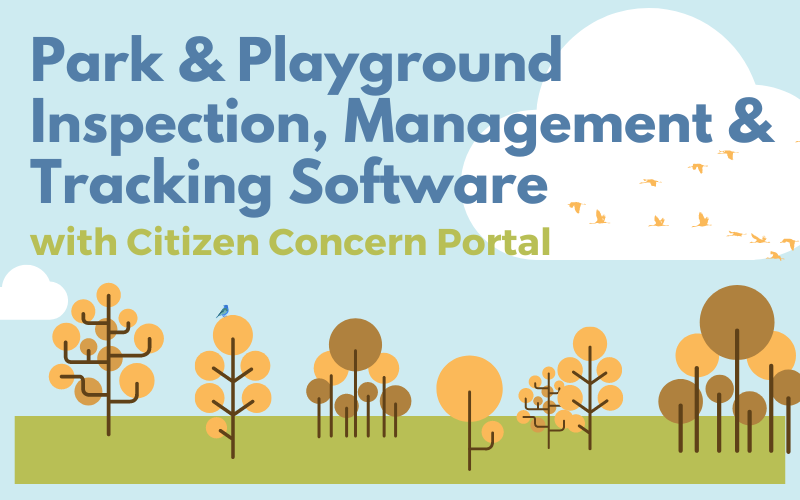Park & Playground Safety Inspections
Park and playground management is a crucial aspect of ensuring the safety and enjoyment of public spaces. Whether it's a city park, a school playground, a municipal playground, or a national park, it's important to adhere to laws and regulations and properly maintain and inspect the facilities to minimize risks and prevent injuries.
National, State or Provincial Park Safety Management

National, State and Provincial parks serve as places for recreation and relaxation, where the natural environment is protected to inspire and educate the public. Preservation and protection of plant and animal life and local ecosystems improve ecological biodiversity and positively impact the region.
Canadian National Parks Visitor Safety
USA National Parks Visitor Safety
Potential Hazards
Common risk factors in national, state or provincial parks include:
- trip and fall hazards
- insect and/or animal bites
- exposure to poisonous plants
- drowning (if there are bodies of water present)
- extreme heat or cold exposure
- snow safety and avalanche awareness
National, State or Provincial Park Safety Regulations
There are several laws and regulations that govern the management of parks. For example:
- Canada National Parks Act (CNPA): establishes the framework for the management of national parks in Canada, including provisions for the conservation and protection of parklands, wildlife, and ecosystems.
- National Park Service Organic Act (NPSA): provides the legal foundation for the establishment and management of national parks in the United States, including provisions for visitor safety and resource protection. State parks in the US are managed by individual states, and their health and safety standards are established under state law.
- Accessibility standards and regulations such as the Americans with Disabilities Act (ADA), the Accessible Canada Act (ACA), Accessibility for Ontarians with Disabilities Act (AODA), or other province-specific regulations.
Environmental protection regulations also require that parks be maintained in an environmentally responsible manner to protect natural resources and ecosystems.
Who's Responsible for National, State or Provincial Park Safety?
The responsibility for health and safety compliance of parks typically falls on the government agency responsible for managing them. For national parks, the National Park Service (NPS) or Canada Parks Agency (CPA) is responsible for ensuring that parks meet health and safety compliance requirements.
In the United States, state park systems are managed by state government agencies, whereas in Canada, provincial parks are managed by provincial government agencies. These agencies are commonly part of departments dealing with natural resources, tourism or culture, such as the Ontario Ministry of Natural Resources.
These park management agencies are responsible for enforcing health and safety regulations, employing park rangers to ensure visitors comply with safety rules, and educating visitors on safety guidelines, among other things.
Municipal Playground Safety Management

Municipal playgrounds are often found in urban areas and are managed by city or county governments. These playgrounds are usually free and open to the public and are especially popular places for children to play.
Potential Hazards
Common risk factors in municipal playgrounds include:
- trip and fall hazards
- unsafe play equipment
- entrapment in equipment
- exposure to lead paint and wood preservatives
- ingestion of loose-fill materials such as sand or wood chips
- unsafe fall protection
Municipal Playground Safety Regulations
Municipal playgrounds are subject to strict regulations, such as those specified by the Consumer Product Safety Commission (CPSC) or the Canadian Standards Association (CSA) guidelines for playground equipment and surfacing.
These regulations cover everything from design, installation and maintenance requirements for playground equipment and surfacing to the height of play equipment and spacing between the bars on climbing structures. In addition, municipal playgrounds must adhere to:
- Municipal health and safety regulations related to the maintenance and use of municipal playgrounds, including preventive maintenance and regular playground safety inspections.
- Accessibility standards, such as the Accessible Canada Act (ACA) or the Americans with Disabilities Act (ADA).
Municipal playgrounds are subject to regular safety inspections to ensure they are safe and well-maintained. The frequency and scope of playground safety inspections vary depending on the specific guidelines and regulations in place.
Who's Responsible for Municipal Playground Safety?
Responsibility for health and safety compliance may vary. In some cities, it may be the responsibility of the parks and recreation department, while in others, it's the city's public works department. In either case, the governing body responsible for park health and safety must conduct regular inspections and maintenance. This includes adhering to guidelines for playground equipment inspection, maintenance, and repairs, as well as playground design and installation guidelines.
The department must conduct regular playground safety inspections to ensure that they are safe for use by children and that any potential hazards are identified and addressed. If they fail to do so, the municipal government could be held responsible for damages.
School Playground Safety Management

School districts usually manage school playgrounds, often used by students during recess and physical education classes.
Potential Hazards
The most common risks and dangers in school playgrounds include:
- trip and fall hazards
- unsafe play equipment
- entrapment in equipment
- exposure to lead paint and wood preservatives
- ingestion of loose-fill materials such as sand or wood chips
- unsafe fall protection
School Playground Safety Regulations
School playgrounds are subject to many of the same playground safety regulations as municipal playgrounds, including those set forth by the CPSC, NRPA, or CSA. In addition, schools may be required to ensure that playgrounds are accessible to students with disabilities.
Who's Responsible for School Playground Safety?
The responsibility for compliance with playground safety regulations typically falls on the school district or school board responsible for maintaining the playground. In most cases, the district or board has a facilities management department responsible for maintaining the schools and their equipment and ensuring that their playgrounds meet health and safety compliance requirements.
This includes adhering to guidelines for equipment maintenance, inspections, and repairs, as well as playground design and installation guidelines. The department must regularly inspect the playgrounds to ensure that they are safe for use by children and that any potential hazards are identified and addressed.
Park and Playground Safety Inspection Requirements

Regular park and playground inspections are critical to maintaining public safety. In a park or playground, several elements need to be inspected, including:
- playground equipment inspection (e.g. swings, slides, climbing equipment)
- surfaces (e.g. wood chips, rubber tiles)
- safety barriers and fences
- amenities (e.g. benches, picnic tables, water fountains, public washrooms)
Specific inspection requirements may vary depending on the park or playground's location and municipal bylaws, but in all cases, the Inspector should be checking the following:
- all equipment is in good condition with no damage, kinked or missing pieces
- impact protection materials are in good condition and maintained at appropriate depths
- no changes have occurred that would necessitate urgent repair or replacement of parts or equipment
Inspectors should also verify that any necessary signage is present and visible, such as warning signs, park rules, or codes of conduct. Learn more about park and playground safety inspections.
Park and Playground Inspection Frequency
Park and playground inspections are essential to public health. Inspection frequency may vary depending on the specific facilities or location, but as a general rule, it should be done to some degree daily, monthly and yearly.
For example, daily visual inspections should be done for glass, vandalism, animal droppings, or other urgent health and safety hazards. Any damaged and dangerous equipment should be removed from service until repairs can be done.
A more detailed monthly inspection should be conducted and documented by an Inspector. And at least once a year, an Inspector should complete a complete and comprehensive site audit. Any maintenance needs or repairs noted on the park/playground inspection checklist should be carried out immediately and documented.
Consequences of Public Safety Violations
Negligence can result in severe consequences when it comes to health and safety compliance in parks and playgrounds. Injuries and accidents caused by negligence can lead to lawsuits and settlements, such as the $270M wrongful death claim facing the National Park Service after an incident at Arches National Park. Neglecting to maintain park facilities in accordance with environmental regulations can also result in fines, penalties, and lawsuits.
Better Inspections with CityReporter

Manual paper systems create backlogs in workflow management and inspections, prolonging the time between when a hazard is identified and when it is resolved. Speed is of the essence when it comes to public safety, especially children's health and safety.
Automated safety inspection software like CityReporter optimizes workflow and helps governments and school boards to eliminate paperwork, data entry and labour inefficiencies to better manage:
- park and playground safety inspections;
- compliance with park and playground safety regulations; and
- loss prevention and risk management.
CityReporter Inspection, Management & Workflow Tracking Software is a user-friendly tool that digitizes the inspection process and makes critical information available anywhere, anytime. Contact CityReporter today for more information.


